If you live in southern Ontario you probably already know the answer to this one: a Northern Flicker. These large woodpeckers are often seen perched in, calling from, and nesting in trees but they don’t often eat in trees. Instead, they feed on the ground.

A male Northern Flicker on a railing.
We have a pair of Flickers nesting in the grassy soccer-field park not far from our home. The park turf is full of ant hills and the Flickers are pleased. They eat many of the ants. When they call from the trees edging the park, they usually just give their simple “rusty gate squeaking” call.
In the spring, however, many Flickers fly through on migration. Groups of 4 or more will perch at the top of still-bare maples or on silvered branches of long dead trees.
Flickers Calling and Flaring Tails and Wings in the Tree Tops
In spring time, I hear them calling their strung-out series of wiks call more than their simple call. You can hear the call I mean on the AllAboutBirds website if you click on the “Rolling rattle call (territorial)” link.
I’m not sure if they call like this to attract other Flickers to join them in a large group or if they are calling in some sort of competition amongst themselves.
When trying to take photos of the Flickers while they were calling like this, I noticed that they often spread their tails and open their wings wide while hopping short distances from one branch to another. I wondered if the males were trying to attract the females, until I realized that the females were also doing this.
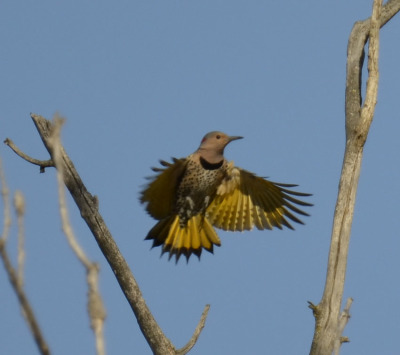
Normally, a Flicker wouldn’t spread its wings and tail this far just to hop from one branch to another. It’s a display for some reason.
In a paper on variation in the colouring of Flickers by Wiebe and Bortolotti, the authors suggest that both males and females “expose the coloured undersides of their flight feathers in exaggerated motions….” and that the display may be “agonistic” if directed at the same sex or an attempt to attract a mate if directed at the opposite sex. They state that these theories have not been proven, however.
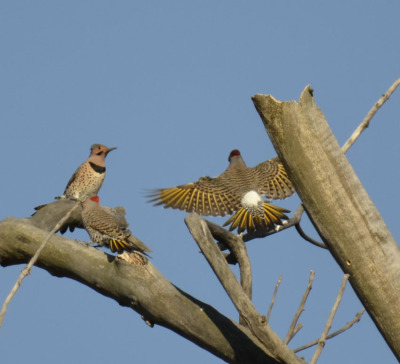
Note the white spot that is usually visible as a Flicker flies away from you.
So I don’t actually know if there is a motive behind this flaring of wings and tail. Certainly it makes the vivid yellow colouring show more clearly and from a distance. (Flickers in western parts of Canada have red under-colours, not yellow.)
Is This a Male or a Female Northern Flicker?
For some woodpeckers, like Downy and Hairy woodpeckers, a red spot on the head means the bird is the male. This isn’t true for Northern Flickers (or Pileated Woodpeckers.) Both males and females have red on their heads.
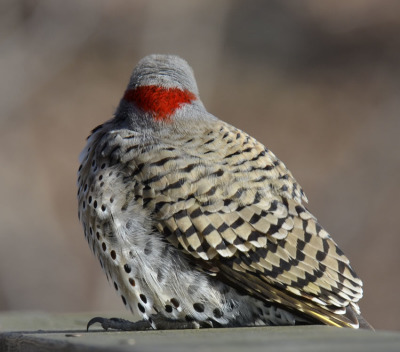
The red on the head is often triangular.
Instead, it’s the presence or absence of a black mustache that is the easiest field mark to look for with Flickers in eastern Canada. (Out west, the moustache is red.)
Why Do Flickers Migrate?
If you have Downy, Hairy or Pileated Woodpeckers in your area, you have probably seen them all winter. They don’t usually migrate like song birds in a north-south pattern. Many Canadian Flickers, however, do.
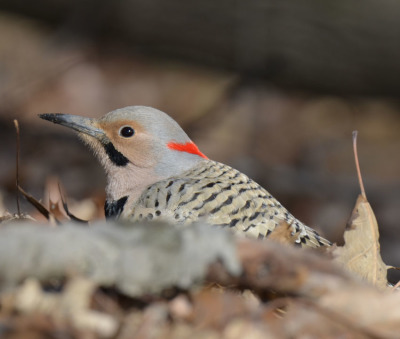
This Flicker on spring migration was feeding on something under the leaves in the forest. Notice the dirty bill from probing deep.
I suspect this is because Flickers prefer to feed on prey on the ground. In the winter, this food supply can’t be reached in most of the Canadian range for Flickers so they move south. Once the ground thaws, though, they return.
Flickers living in the warmer US states often do not migrate.
What Do Flickers Eat?
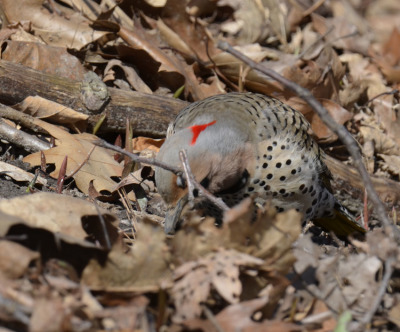
Perhaps the red is to help other Flickers find each other on the forest floor?
When they raid an ant hill, the Flickers munch on the larvae. They also eat beetles, moths and other ground insects.
According to the AllAboutBirds website, Flickers will also eat fruit and some seeds. They’ve been seen feeding on dogwood berries, sumac, and elderberries. They will sometimes eat sunflower seeds at feeders.
Flickers can feed on insects in and on trees. They just seem to prefer to hunt at ground level.
I’ve enjoyed seeing many Flickers this spring. I just wish they didn’t trick me with their loud wikka-wikka-wikka calls into thinking they were something more unusual!
Related Reading
- How to Decide if a Woodpecker is a Downy or a Hairy
- Are Pileated Woodpeckers Increasing in Numbers in Southern Ontario?
- Why Is That Tree So Noisy?
Join In
Do Flickers nest in your neighbourhood? Please share your experiences with a comment.

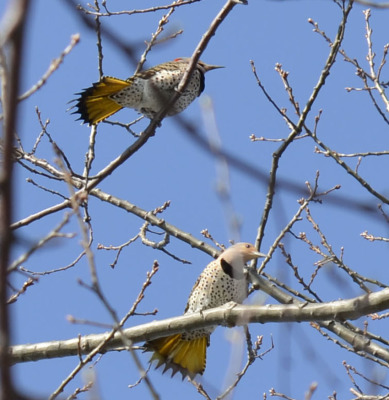
Saw one of these at the library in blackstone ma thought it was a rose crested woodpecker it was feeding on ground insects. Verry cute bird about the size of a dove. Red spot on back of head
They are quite interesting to watch–thanks for sharing!
Hi! I was just admiring a recent arrival, a dark brown feathered Flicker.
Very cool looking bird and unique sound.
God bless.
Sounds like a good day!
My moms house in franklin ma has been freequeted by a large plliated woody woodpecker for the last couple of years. Another beautiful site
Yes, they are quite impressive birds!
I do a lot of fishing at rivers and see a large variety of birds and wildlife and will post here with pictures when possible
Unfortunately there is no way to share your photos here. If you like, you may want to join eBird.org to post your photos. They help others in your area know what’s there, too.
I saw this Norther Flicker on our lawn yesterday and today. In the very same spot. I can see the red head and the beautiful speckled wing. When it flew away, I saw the white spot on the back. I did not see the beautiful front. So excited as my garden is tailored for wildlife, butterflies and bees. I haven’t seen a new bird for a long, long time.
They are a very striking bird–thanks for sharing!
Oh, to continue. We are on Lake Simcoe, an hour north of Toronto.
Thanks!
I just rescued a Northern Flicker from inside my house! I have no idea how it got inside. Beautiful bird. I wish I had snapped a photo. It allowed me to scoop it up into my hands and release it outside. Trying to figure out if it was male or female. Amazing!
Wow! That has to be an amazing experience!
Just saw this large bird at the base of my cherry tree. The red triangle shape in the back of his head was striking! I’ve never seen anything like it in our yard in Indian Trail NC.
We have snow on the ground so our Flickers have left for the winter–Thanks for sharing yours!
I watched one of these beautiful flickers yesterday and today as it pecked first in the abundance of fallen leaves then to the hillside grass….in Barryville, Sullivan County NY, USA! Thank you Canada for sending them south!
Thanks for letting me know they are working their way back here! Stay well!
Saw my first flicker once I could identified it. Sure hope he/she sticks around however, we seem to be a fly way here in northern Ontario. It is a real treat to see spring come but I am sad in the fall as the Canada Goose departs for the winter.
I can understand the fall feeling–I love the feeling as the last of the snow slowly melts and you realize that all of the good things of spring and summer are still ahead. I’m not fond of watching the last migrants departing. At least here near the Lake most years if it doesn’t freeze tight we get the winter ducks to watch. Enjoy the spring!
Saw two in my Garden this evening in Yonkers NY looking for grubs. Had never seen this bird before, very striking appearance with the red spot on the back of the head and the black markings on the chest. Hope they visit again
They are certainly a colourful bird. I hope a pair stays to nest in a hollow tree in a park near you. If so, they may visit again!